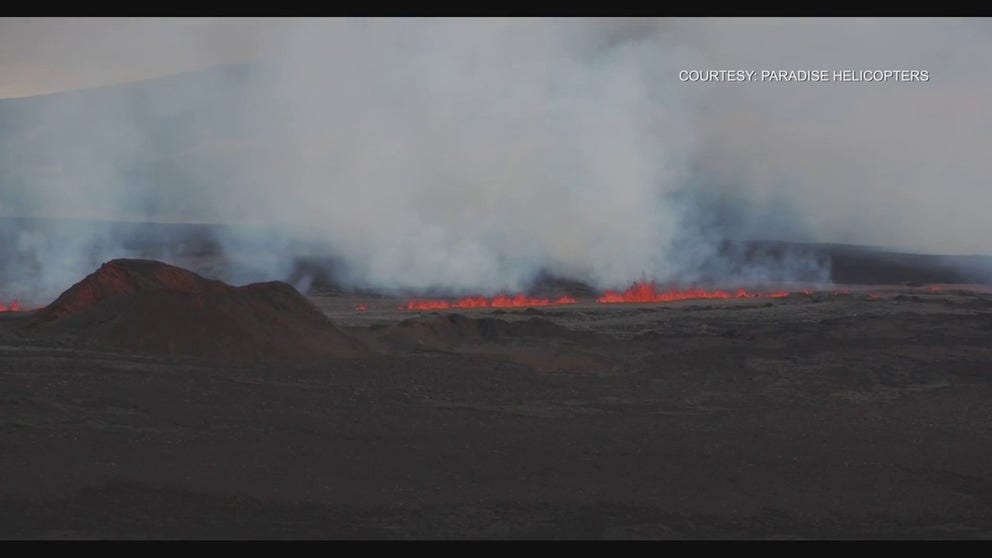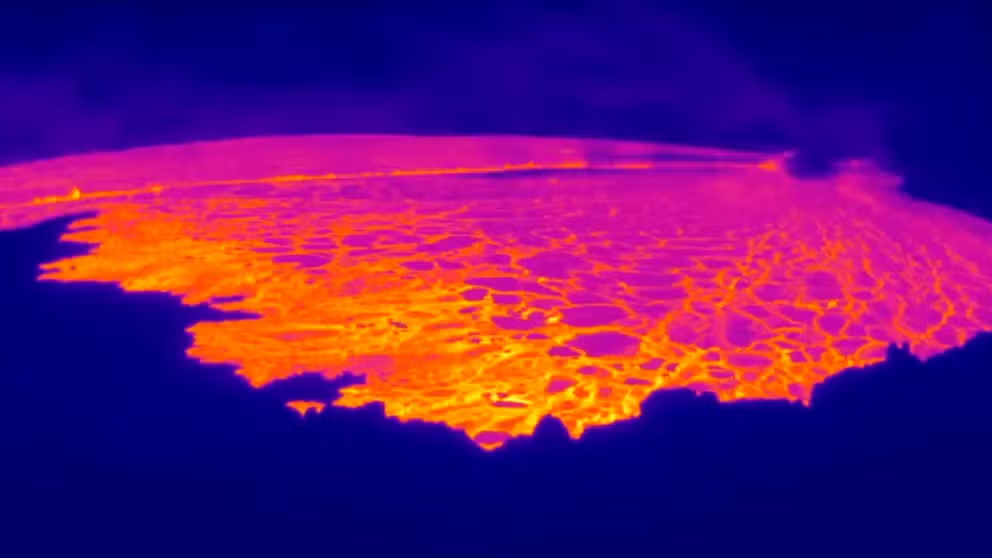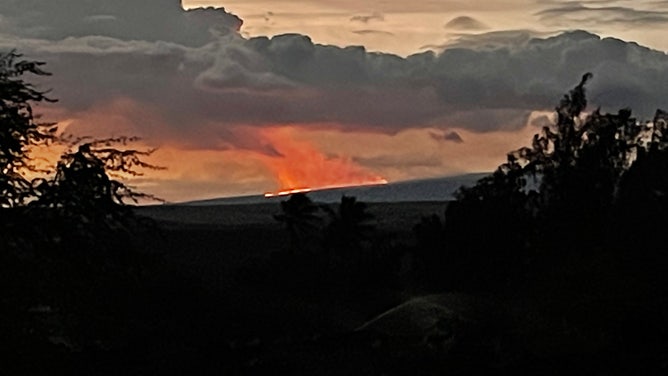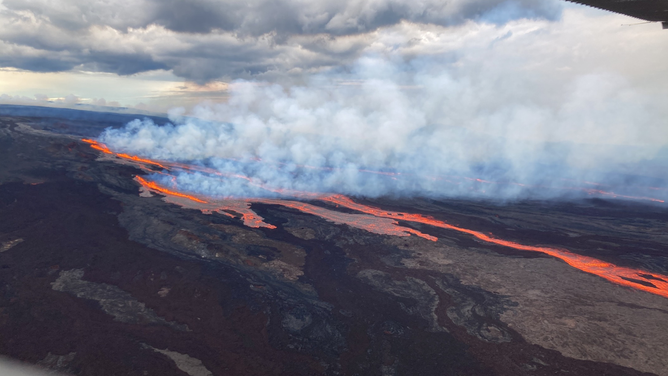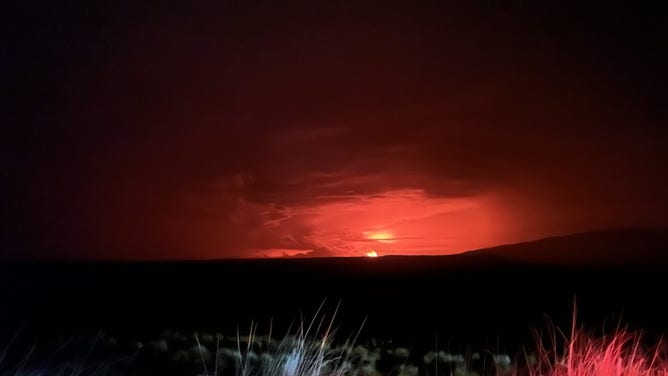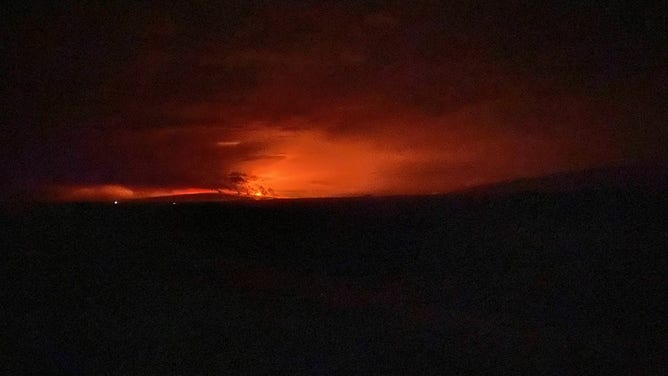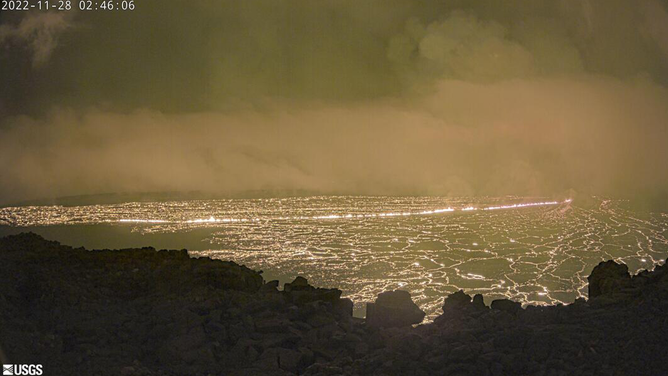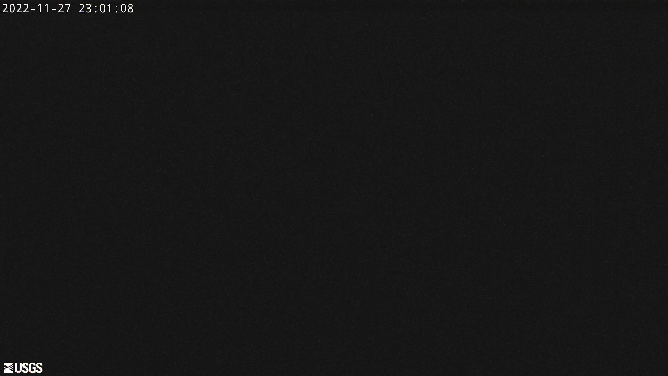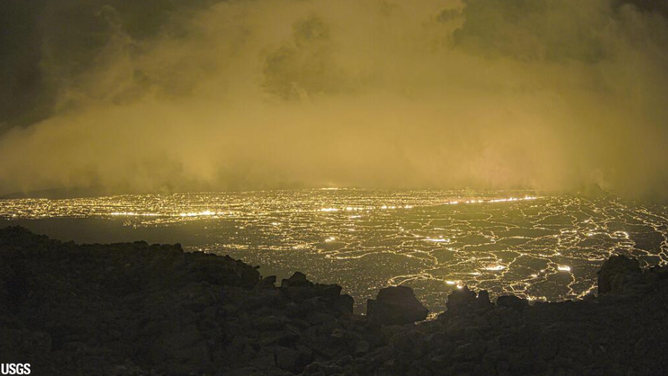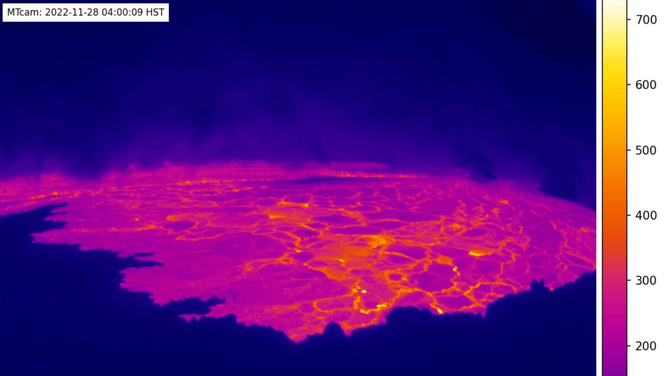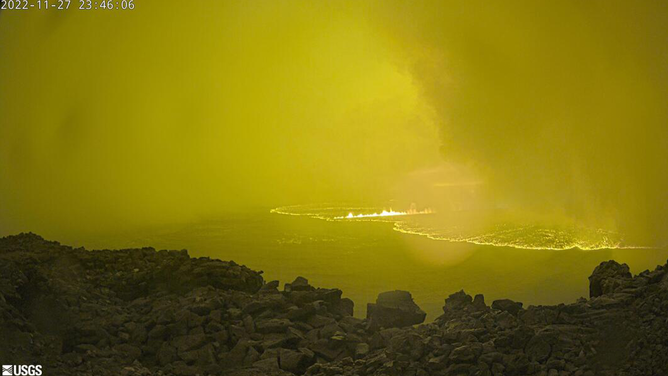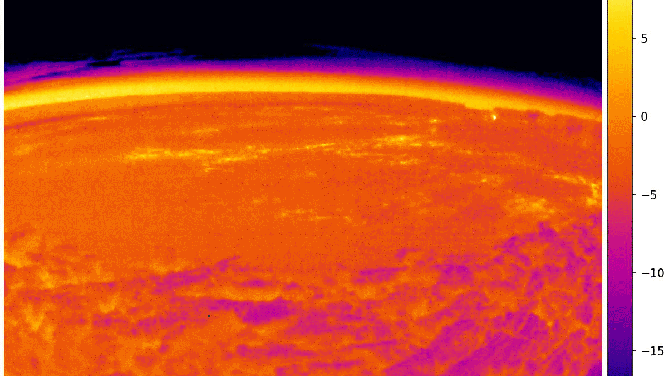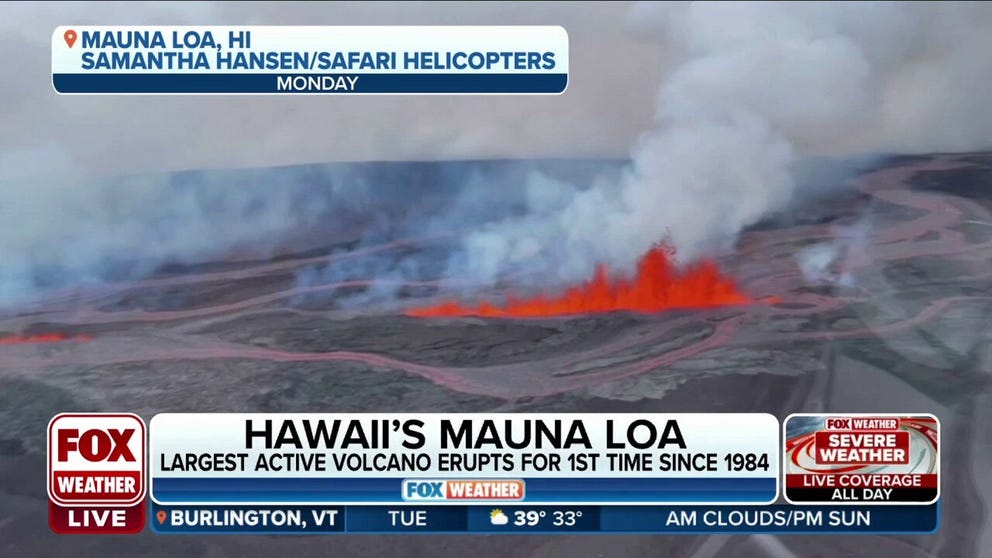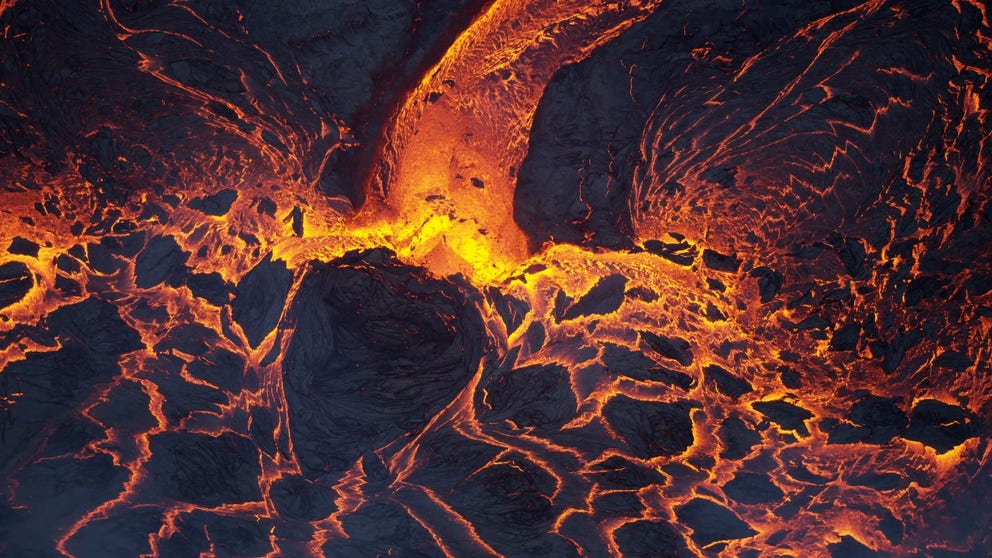Eruption of Hawaii’s Mauna Loa volcano sends lava shooting hundreds of feet into the air
Scientists had been keeping an eye on Mauna Loa over the past few months when the world's largest active volcano began showing signs of increased seismic activity, including a magnitude 5.0 earthquake that shook Hawaii's Big Island in October.
Watch: Firefighters survey Hawaii's Mauna Loa eruption from the air
Firefighters captured video of Mauna Loa's eruption from a helicopter on Monday afternoon.
HAWAII VOLCANOES NATIONAL PARK – Hawaii's Mauna Loa volcano awoke from a nearly 40-year slumber on Sunday night during an eruption that shot lava hundreds of feet into the air and prompted a warning from officials for residents to begin reviewing emergency plans.
Scientists had been keeping an eye on Mauna Loa over the past few months when the world's largest active volcano began showing signs of increased seismic activity, including a magnitude 5.0 earthquake that shook Hawaii's Big Island in October.
HAWAII'S MAUNA LOA, WORLD'S LARGEST ACTIVE VOLCANO, ERUPTS FOR FIRST TIME SINCE 1984
Watch: Lava flows from Hawaii's Mauna Loa volcano
Hawaii's Mauna Loa volcano erupted on Sunday for the first time since 1984.
"For the past couple of months, Mauna Loa has been in a state of elevated unrest," said Wendy Stovall, a volcanologist with the USGS. "We were detecting an increased number of earthquakes as magma moved through the volcano and fractured the ground."
Stovall also said Mauna Loa was swelling outward as the magma was moving.
"So, we were able to detect that with the instruments that we have on the surface of the volcano," she said "And then about an hour before the eruption occurred, a very high rate of earthquakes started up that signaled that the magma was moving from a summit storage region up to the surface."
World's largest active volcano, Mauna Loa in Hawaii, erupts overnight for first time in decades
For the first time in 38 years, Hawaii’s Mauna Loa volcano began erupting on Sunday night.
And then, on Sunday around 11:30 p.m. local time, Mauna Loa erupted, ending the longest quiet period between eruptions on record.
The United States Geological Survey said the eruption began in Moku‘āweoweo, the summit caldera of Mauna Loa, but migrated from there to the Northeast Rift Zone by early Monday morning.
Scientists with the Hawaiian Volcano Observatory (HVO) reported fissures in higher elevations within Hawaii Volcanoes National Park were feeding lava flows upslope of the Mauna Loa Weather Observatory.
Lava flows were not threatening downslope communities, but officials warned volcanic gas, fine ash and "Pele's Hair" could have been carried downwind.
WHAT MAKES 'PELE'S HAIR' DURING A VOLCANIC ERUPTION?
Emergency officials asked residents at risk of lava flows from Mauna Loa to begin reviewing emergency plans and refer to Hawaii County's civil defense for further guidance and other important information regarding Mauna Loa's eruption.
"First and foremost, you just need to follow the directions by the emergency management personnel that are actively monitoring the situation to make sure that they keep everyone safe," Jon Jelsema, senior forecaster for the National Weather Service in Honolulu, said on FOX Weather Monday morning.
LAVA FLOWS FROM MAUNA LOA VOLCANO CREATE GLOWING SKY ACROSS HAWAII'S BIG ISLAND
Mauna Loa's lava flow still weeks away from any potential threat to public
Wendy Stovall, Volcanologist at USGS, says the lava flow from Mauna Loa is still weeks away from any potential threat to the public if the eruption happens to occur for that long.
Scientists with HVO said three fissures in the Northeast Rift Zone erupted, and as of Monday afternoon, only the lowest of the three was active.
Scientists said the tallest lava fountain heights were estimated to be between 100 and 200 feet, but most were only a few yards high.
Those fissures sent lava flows to the northeast and parallel to the rift zone, and lava flows from the two higher fissures moved downslope but stalled about 11 miles from Saddle Road.
The third fissure fed lava flows moving east parallel to the Northeast Rift Zone and remained above 10,000 feet in elevation and more than 10 miles from Saddle Road.
"We do not expect upper fissures to reactivate," the USGS said in a Mauna Loa eruption status update. "However, additional fissures could open along the Northeast Rift Zone below the current location, and lava flows can continue to travel downslope."
The USGS said there were no active lava flows within Moku'āweoweo caldera, and there was no lava erupting from the Southwest Rift Zone as of Monday evening. Scientists also said they didn't expect any eruptive activity outside the Northeast Rift Zone, and no property was at risk.
Mauna Loa history
Watch lava flow in these mesmerizing volcanic eruptions around the world
Experience the power and majesty of a volcano up close in this awe-inspiring video.
Since 1843, Mauna Loa has erupted 33 times, averaging an eruption every five years.
However, most eruptions before 1950 had an average frequency of 3.5 years. Since 1950, there have only been two eruptions – a summit eruption in 1975 and a rift eruption in 1984.
It had been the longest quiet period on record for Mauna Loa before Sunday night's eruption.

